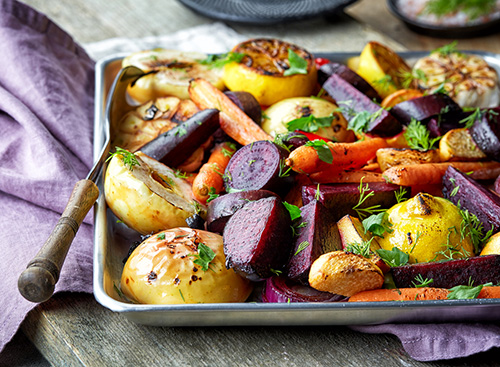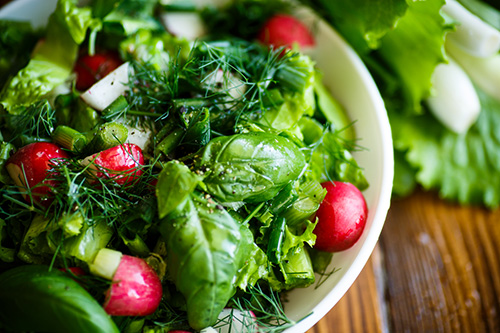Authored by Dr. Sharon Stills, NMD
You and a coworker share a pizza for lunch and a few hours later, she is zipping along while you feel tired, bloated and miserable. How can two people have such different reactions to the same food?

Ayurveda answers this question. It’s the ancient medical system of India, and one of its central ideas is that there are four different Ayurvedic digestive types. You need to know your type to know what foods will help you — and which will hurt you. It also tells you which foods you should add or subtract from your diet in order to heal your symptoms.
So when a patient comes to me for help with digestive symptoms — gas, bloating, acid indigestion, diarrhea, constipation and fatigue after eating — I always identify her Ayurvedic digestive type.
Ayurveda differentiates between four different kinds of agni — or “digestive fire.” Simply knowing which of these categories your digestion falls into can reveal a surprising amount of information about your symptoms after eating certain foods — and what you can do to bring balance back to your digestion. It’s surprisingly easy to figure out which of the Ayurvedic digestive types best describes you. Watch my video and read the descriptions below — you’ll find yourself and everyone you know well, too!
Visham agni
Visham agni is unpredictable digestion. Sometimes your favorite foods go down easy and other times they trigger gas and bloating and other symptoms. Or you may notice that your bowels are moving normally and then suddenly you’re having constipation or diarrhea, even when your diet hasn’t changed much.
Unpredictable digestion is tied to vata, the Ayurvedic element of wind. As we know, wind can be very changeable — sometimes it’s very still and sometimes the wind picks up and all of a sudden everything is blowing around.

If you’re a visham agni type, Ayurveda says you can counter the wind by eating warming, grounding types of foods — such as roasted root vegetables, stews and soups, and even cooked apples.
Foods considered cold foods — like salads and smoothies made from raw veggies and raw fruits — will not be helpful in pacifying your vata. Skipping salad might sound counterintuitive to healthy eating, but if you’re open to it, you will soon discover a new world of steamed greens and wilted spinach salads that will keep you grounded and feeling good.
Tikshna agni
Tikshna agni refers to sharp or excessive digestive fire. Common signs that you are dealing with tikshna agni include hyperacidity, heartburn, acid reflux, excess acid ulcers and running to the bathroom with burning diarrhea after eating your meals.
If this describes you, you want to calm and contain the flames of your tikshna by eating more cooling, hydrating foods like juicy fruits and aloe vera juice. When you cook, add more cooling herbs like fennel, mint and cilantro to your dishes. Pomegranate, oatmeal, tapioca and okra are other foods that can help reduce inflammation in a tikshna type’s digestive tract.

Foods that can be problematic when you have tikshna agni are things like cayenne, chiles and onions and garlic — they will only get you even more fired up!
Manda agni
Manda agni is slow digestion related to an excess of kapha, the earth element. When you have slow digestion, you eat a little bit of food and you feel stuffed or you eat some food and you just don’t feel like it’s digesting — it’s just sitting there in your stomach. Or you eat and then feel exhausted. You may also experience large sticky stools and a decrease in your appetite.
If you’re a manda agni type, you want to eat light, stimulating foods such as non-starchy vegetables. Manda agnis do well with a big fresh salad or a smoothie. Foods to avoid include dairy and sugar and excess protein — things that are just going to gunk you up and slow you down.

Manda tip! To stoke your digestive fires, it can help to drink a warm cup of ginger tea about a half hour before your meal.
Sama agni
Sama agni is the Ayurvedic state of balanced digestion, which generally means having one to three bowel movements a day. You’re not having any other digestive symptoms. Plus, you have radiant skin and your eyes are shining.
If this is already you, keep it up! If you have some work to do to achieve balance, I encourage you to really lean into your type and give dietary changes a chance to start the process of digestive healing.

When you achieve sama agni, you want to really be eating according to the seasons to maintain this wonderful balance. Cook seasonal foods or eat raw according to what’s best for your digestion.
Now that you know about the Ayurvedic digestive types, what changes are you going to make?
 | Super Biotic reduces and prevents digestive symptoms. Find out how it can help you. |












